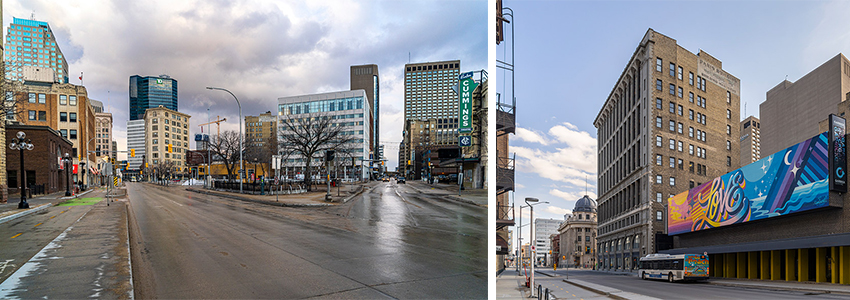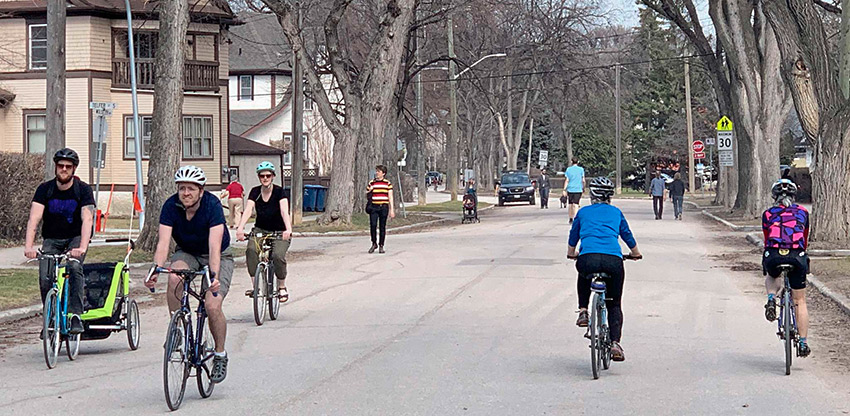
By Kendra Friesen, Architectural Technician
I have often thought how neat it would have been to create a time lapse during the pandemic. Same street corner, same time of day, all the way through the depths of this unique time. I would be curious to see how our city’s patterns have changed and what the emptiness and the ebb and flow of humanity truly looks like.
As many took refuge in their own homes, our city became quiet. One could cross Portage and Main as a pedestrian or cycle down Bannatyne Avenue towards Waterfront Drive without encountering a single vehicle. The streets became barren. Although it was shockingly different at first, it became the new normal almost overnight.

Images: Early on in the pandemic, downtown Winnipeg often times felt like a different city during the middle of the day with a lack of vehicle and pedestrian traffic. These images were both taken during usual busy hours. (Photos: Mike Pratt)
Suddenly, the vehicle didn’t take precedence. Roads like Wellington Crescent, Scotia Street and Lyndale Drive held such a thrill: Pedestrians, cyclists, skateboarders and scooters had the power. They were finally the majority. Whether walking, biking, or running, I was part of this growing majority. It was such a power trip and I loved it.

Image: It didn't take long for active transportation routes to start popping up throughout the city, creating safe environments for people to get outside without having to worry about vehicular traffic. (Photo: Brent Bellamy)
Although gasoline and diesel were dirt-cheap, there was nowhere to go in a vehicle. The acrid smell of fumes didn’t linger in the air and in many parts of the world, the smog was…just…gone.
Our Sustainability Committee started thinking about the huge number of individuals who have stopped driving to work, either because of working from home or a layoff, and how this has taken so many cars off the road. Although some Number TENers already biked, ran, bussed or walked to work prior to the pandemic, we began wondering if we, individually and collectively, were drastically reducing our carbon
footprint through working from home. I surveyed both our Winnipeg and Victoria office and asked the following questions:
![]()
(It should be noted that this survey was an overview of our approximate carbon reduction through working from home and making less job site visits and as such, does not factor in additional heating, cooling and electrical requirements at home, idling in traffic prior to or during COVID-19, or required driving for after-work activities.)
As I saw the number of responses climbing and the positive feedback from coworkers, my excitement grew and I wondered, can we make a difference? Have we already made a difference?  Erns Wall, one of our interior designers on the committee, offered to analyze our data. He first did some research into statistical averages put out by Stats Canada and found that the average age of vehicles on Canadian roads is 9.66 years, which means the efficiency data needed for our survey would be taken from the 2010-2011 fleet. From that fleet, the average GHG Emissions Performance for Passenger Automobiles was 158.45 grams of CO2/km. For buses though, the average CO2 emissions/passenger is 68 grams/km. It’s important to note that although the CO2 emission data for buses is European, our Canadian stat will be quite similar.
Erns Wall, one of our interior designers on the committee, offered to analyze our data. He first did some research into statistical averages put out by Stats Canada and found that the average age of vehicles on Canadian roads is 9.66 years, which means the efficiency data needed for our survey would be taken from the 2010-2011 fleet. From that fleet, the average GHG Emissions Performance for Passenger Automobiles was 158.45 grams of CO2/km. For buses though, the average CO2 emissions/passenger is 68 grams/km. It’s important to note that although the CO2 emission data for buses is European, our Canadian stat will be quite similar.
Using these stats, Erns analyzed our data and found some staggering results. We’ve emitted 84% less carbon into the atmosphere each week during COVID-19 simply by working from home. 84%, that’s huge! Each week which we’re working from home, we’re reducing our carbon emissions by 507kg, or an average of 8.5kg/person. If we applied this average to all 15.45 million people employed in Canada, that would be 130,552,500 kg of CO2 not emitted into the atmosphere each week. Wow! Of course, this is a huge generalization and our small sample size of 60 people in two cities doesn’t accurately reflect the rest of Canada, nor would every employed person in Canada even be able to work from home. However, this data gives us a rough idea of what this could look like on a large scale.
We’ve emitted 84% less carbon into the atmosphere each week during COVID-19 simply by working from home. 84%, that’s huge! Each week which we’re working from home, we’re reducing our carbon emissions by 507kg, or an average of 8.5kg/person. If we applied this average to all 15.45 million people employed in Canada, that would be 130,552,500 kg of CO2 not emitted into the atmosphere each week. Wow! Of course, this is a huge generalization and our small sample size of 60 people in two cities doesn’t accurately reflect the rest of Canada, nor would every employed person in Canada even be able to work from home. However, this data gives us a rough idea of what this could look like on a large scale.
What is also interesting to note from our survey is that that although only 43% of those surveyed commute by themselves in a vehicle, they make up a staggering 78% of commuting carbon emissions. On the other hand, 22% of those surveyed commute via public transit, but they contribute only 15% of carbon emissions. These numbers show for themselves what our commuting choices are doing to the atmosphere.
I was shocked but so excited. It turns out that we CAN make a difference and have ALREADY made a difference. This begs the question: Will this empower us to create long-lasting habits? Can we, individually and collectively, change our rhythms to remain more environmentally sustainable?
But I had to press pause on this excitement. Our data shows incredible results, but we can’t simply say that this means of living is ideal. Simply working from home long-term isn’t the answer. It’s a breeze for some, while it is quite challenging for others. Sometimes new rhythms are quite difficult to sustain, especially when they’re forced on us. Looking at the positives in everything isn’t always helpful and sometimes doing so makes us feel worse about our situation. We simply cannot look at the environmental benefits of this pandemic with rose-coloured glasses and fool ourselves into thinking this sort of living is physically, mentally, emotionally, socially and spiritually sustainable long-term just because it temporarily benefits the environment.
And so how do we adjust our new normal to reflect the lessons learned here? How do we maintain an 84% carbon reduction? Can we?
We like to see instant growth and monumental change but all too often, we realize this newness which we’ve chosen is too much and we begin to miss the comfortable rhythms we’d previously established. These monumental new rhythms are daunting and relentless, and so we give up and crawl back to our old, familiar rhythms.
So then what?
Baby steps. Stepping away from the computer, video games and cellphone for a moment, and easing ourselves into movement. Stepping outside for a walk in the park, a bike ride down the street, or a run along the river. Choosing a Sunday bike ride instead of a Sunday cruise. Commuting via walking, biking or public transit instead of driving. We’ve seen the proof that a reduced carbon footprint is possible, now we need to find balanced and healthy ways to sustain it.
Little by little though, I think we can get there. We can meet our basic needs while living within a reduced carbon footprint. And I think our souls, our relationships, and our earth will thank us.
Kendra is an Architectural Technician at Number TEN Architectural Group